What do you do after a tooth extraction? In most cases, while still in the corridor of the clinic, the patient begins to consider the postoperative (and tooth extraction is a real operation) wound, and quite often its appearance inspires a person with a sense of fear. But the main questions arise after the anesthesia stops, when the pain returns: is this normal, can the pain indicate the development of a complication, is the gum in a normal state after tooth extraction and how long can blood flow and is this the norm? This article will provide materials that will help clarify the situation and answer frequently asked questions.
Preparing for the tooth extraction process
If the patient is interested in the process of tooth extraction even before the manipulation itself, then the information below is briefly presented that will avoid most complications after the procedure:
Do not postpone this procedure until the moment when pain occurs. The pain syndrome indicates that an inflammatory process develops in the tissues, and if such a pathological process reaches the gums, it swells, loosens and its blood supply increases. Removing a tooth from such a gum will lead to prolonged bleeding, which will differ in intensity from the norm. In addition, if the cause of pain is the formation of a cyst (a hollow formation with dense walls, the cavity of which is filled with pus) on the crown of the tooth, then during the dental procedure, the risk of infection of the jaw bone, gums or tooth socket increases.
If a woman is to undergo a tooth extraction procedure, it should not be planned for the time of menstruation: at this time, bleeding will last longer, since the body's strength in relation to blood clotting is weakening.
It is better to schedule a visit to the dentist-surgeon in the morning. In such cases, when removing wisdom teeth or other complex manipulations, you can resolve the issues that have arisen during the day, and not look for round-the-clock dentistry.
Local anesthesia. If the patient of the dental surgeon is an adult and the manipulation does not involve general anesthesia, it is advisable to eat before the procedure. Thus, prevention of a decrease in blood glucose levels during the period of surgical manipulation is performed, and in a well-fed person, the process of blood clotting occurs faster.
When planning general anesthesia, you need to contact the dentist before the manipulation itself, the doctor will conduct a general examination and appoint a consultation with the anesthesiologist. Such anesthesia, on the contrary, excludes the use of food and even drink. The last meal should be taken 4-6 hours before the operation, since the administration of drugs can provoke vomiting, and the vomit, in turn, threatens to enter the respiratory tract.
Tell your doctor if you have any allergies to medications or any medications you are currently taking.. If you plan to remove a tooth in a person with heart pathologies that involve the constant use of blood-thinning drugs, you should inform the dental surgeon about this, and also consult with the attending cardiologist regarding the short-term cancellation of these pharmaceuticals. In such cases, if you stop taking Cardiomagnyl, Warfarin and do not inject Fraxiparine and Clexane the day before the dental intervention and exclude them for another 48 hours, you can avoid bleeding in the postoperative period. If the patient did not have time to perform this action, it is necessary to inform the surgeon about the availability of such treatment. It is also necessary to inform the doctor of all the features of the existing allergy.
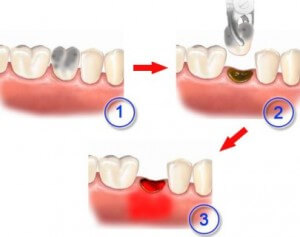
Briefly about the extraction procedure
As mentioned above, tooth extraction is a complete operation. It involves the same steps as with other surgical interventions:
processing of the surgical field;
anesthesia.
Before the intervention, a local variant of anesthesia is used, namely, a local anesthetic is injected into the area of the exit of the nerve that innervates the necessary tooth. Modern preparations of this action are contained in special ampoules - carpules. Such carpules, in addition to the anesthetic itself, also contain a vasoconstrictor. This is necessary in order to reduce the amount of blood lost during the manipulation.
In some cases, the dentist uses local anesthetics that do not contain such vasoconstrictor drugs. They are added independently, while the doctor can further increase the dose of such drugs. It is also worth noting that when the drug is injected into the area of inflammation with acid pH reactions, part of the anesthetic is inactivated, as a result of which additional anesthesia may be required. Both points are very important in the postoperative period.
Direct removal.
After numbness of the gums and its anemia (narrowing of blood vessels), the dental surgeon proceeds to the process of direct tooth extraction. This requires loosening the ligament that holds the tooth, and in some cases this must be done with a scalpel. The tools and time of manipulation is determined by the doctor and may be different, it all depends on the severity of the situation.
The operation ends with the treatment of the resulting wound.
If the gingival margins are far apart, or in cases of traumatic extraction, suturing the wound may be necessary. In the absence of such a need, a gauze swab moistened with a special hemostatic solution is applied over the injury, which is pressed into the hole with two jaws. The essence of stopping bleeding is not only in the hemostatic preparation, but also in the compression of the wound. Therefore, do not rush to change the tampon when it is soaked with blood, but it is better to press it well against the gum with your jaws.
Postoperative period - anesthesia is still in effect
Usually the algorithm is as follows: the doctor removes the tooth, puts a gauze swab and orders to hold it for about 15-20 minutes, and then spit it out. In the future, at best, the wound is examined for bleeding, and after the doctor is convinced that the bleeding has stopped, the patient is allowed to go home, at worst, the patient goes home, throwing out the tampon along the way.
Pain- in the first 3-4 hours after the manipulation, the anesthetic still continues to act, so the pain from the extraction is either not felt at all, or is slightly felt. A kind of exudate with streaks of blood is released from the hole - an ichor. Its separation lasts for 4-6 hours, and this is visible when spitting and opening the mouth. If a wisdom tooth was removed, then given its abundant blood supply and a significant area of injury in the area of operation, the ichor can be released during the day.
Hole after extraction of the tooth, it looks like this: there is a clot of scarlet blood in it. You cannot delete this clot, because it:
prevents vascular bleeding at the bottom and sides of the hole;
protects the well from infection;
gives rise to soft tissue that will replace the lost tooth in the future.
Blood may be excreted in small amounts after removal (normal) if:
a person suffers from liver pathologies;
takes blood thinners;
the operation was performed on inflamed tissue (the tissue is edematous and the vessels do not collapse well);
the tooth was pulled out traumatically.
Such bleeding should not be profuse and after 3-4 hours it transforms into a separation from the wound of the ichorus. If the blood stopped and reappeared after 1-2 hours, then this indicates the onset of the second phase of the action of the vasoconstrictor drug, namely, vasodilation.
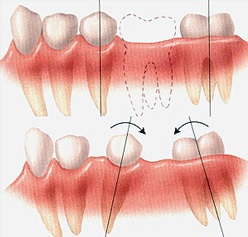
In all the above cases, you need to perform the following actions:
calm down. You need to know that bleeding from the hole of a pulled out tooth was fatal in only one case, and then the deceased woman died not from the bleeding itself, but from blood entering the respiratory tract when she herself was in a state of extreme intoxication. The bleeding did not stop in her as a result of the presence of cirrhosis of the liver, which is known to disrupt the blood coagulation process, while the patient had three teeth removed at once;
if the bleeding is quite severe, you need to contact the surgeon who performed the extraction again. At night, you can go to an on-duty private or public clinic, but only if the blood is scarlet or dark in color and stands out in a trickle. Otherwise, you must proceed to the implementation of the following points;
make a tampon out of sterile gauze, and install it yourself so that the edge of the tampon does not touch the blood clot in the hole, then clamp the tampon with your jaws for 20-30 minutes;
if bleeding develops against the background of the use of anticoagulants and the patient suffers from chronic pathologies of the blood or liver, or when an abundant amount of blood is released, you can use the "Hemostatic Sponge", which is sold in pharmacies. The sponge is also applied over the hole and pressed using the opposite jaw;
in addition, you can take the drug Dicinon or Etamzilat 1-2 tablets 3-4 times a day;
hydrogen peroxide should not be used, since its components react with blood, as a result, the clot in the hole is also partially fragmented, which can provoke increased bleeding.
How many days after tooth extraction should bleeding stop completely? It takes 24 hours to completely stop bleeding. The presence of later bleeding indicates the presence of complications that should be excluded or confirmed during an unscheduled examination by the dentist.
swollen cheek can be observed in this period, only if the edema was present before the operation. If the flux was absent before the operation, then even with the development of any complication of swelling of the cheek, it will not be able to manifest itself in such a short time.
Temperature after the operation, during the first 2 hours, an increase in body temperature up to 38 degrees can be observed. This is how the body reacts to intervention. Most often, the temperature is in the range of 37.5 0 C, and in the evening it rises to a maximum of 38 0 C.
How to rinse your mouth after tooth extraction? In the first couple of hours after the manipulation - nothing, in order not to violate the integrity of the still loose blood clot in the tooth socket.
Postoperative period after the end of anesthesia
Pain- noticeable, because the sensitivity of the gums appears and the pain in the hole begins to disturb (normally, the pain can last up to 6 days, but it does not increase).
Hole looks the same as 2 hours ago, the blood clot persists.
Blood- after the end of the anesthesia, it may begin to stand out more strongly, most often it is not blood, but ichor. This is due to the fact that there is an expansion of blood vessels, which had previously been narrowed by vasoconstrictor drugs and adrenaline. If you use the recommendations presented in the previous paragraph: tamponade with gauze or with a hemostatic sponge, you can take a couple of Etamzilat tablets, in most cases this stops the condition.
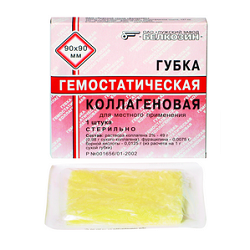
How to rinse your mouth? Until the end of the first day after removal, rinsing is contraindicated, baths can be used, for this, a solution is taken into the mouth and the head is tilted towards the removed tooth, without rinsing movements. Such baths are indicated only if there are inflammatory or purulent processes in the oral cavity before the intervention (gingival suppuration, pulpitis, cysts). During the first day, only salt baths are used: for one glass of water, one tablespoon (tablespoon) of salt. Hold for about 1-3 minutes, repeat - 2-3 times a day.
Temperature after removal, it normally lasts for one day, while it should not exceed 38 degrees.
cheek swelling, but if bleeding did not increase, headache, nausea did not appear, appetite did not decrease, during the first two days it is one of the normal options. In the future, if there is no increasing swelling over the next 2 days, you should also not panic. But if:
cheek continues to swell;
swelling extends to neighboring areas;
the pain becomes more pronounced;
nausea, weakness, fatigue appear;
temperature rises,
this indicates the development of complications. It is urgent to consult a specialist.
Second-third days
Hole can scare a lot of people. The fact is that gray and white stripes of tissue begin to form over the blood clot. Do not be afraid - this is not pus. This type has fibrin, which helps the blood clot to thicken, so that later the soft tissue of the new gum grows in its place.
Pain after removal is present and requires pain medication. When the healing process has a normal, uncomplicated course, the pain weakens every day, while its character is a characteristic feature - aching, pulling, but not pulsating or shooting.
Why do many patients complain of bad breath after tooth extraction? A similar smell from the mouth may be present and this is the norm. The accumulation of blood, which goes through its natural stages of friability, and then a dense blood clot, has an unpleasant sweetish odor. In addition, usually the patient receives a ban on brushing and rinsing their teeth for 3 days as a prescription, so there is an active accumulation of bacteria in the mouth, which increase the unpleasant odor. You should not worry about the smell, especially if the general condition is satisfactory, there is no fever, and the pain gradually begins to subside.
You can talk about an uncomplicated course of the period after surgery if:
when you press the gum, the exudate from the hole does not separate;
pain - aching, dull, not shooting. Also, there is no increase in it during meals;
normal appetite;
a constant desire to lie down and weakness are absent;
temperature increase is not observed even in the evening;
swelling of the cheek remains at the same level as yesterday, does not increase;
blood after 2-3 days is not allocated.
You need to contact your dentist if:
saliva or food is determined in the well;
pain increases when eating, even if its character is aching, weak;
when you touch the gum in the region of the hole, pain occurs;
the edges of the gums are stained red.
How to rinse the mouth during this period?
decoction of calendula, eucalyptus, chamomile. Prepare according to the recipe presented in the instructions, do baths for 2-3 minutes three times a day;
furacilin solution - ready-made or diluted independently (10 tablets per 1 liter of water, boil, or 2 tablets per glass of boiling water): perform 1-2 minute baths, the manipulation can be repeated up to 2-3 times a day;
soda-salt solution (a teaspoon of salt and soda per glass of water): baths for 2 minutes, just hold in your mouth, repeat 2-3 times a day;
miramistin solution: baths for 1-3 minutes, 2-3 times a day;
an aqueous solution of chlorhexidine (0.05%): keep in the mouth for at least a minute. Rinse to perform three times a day.
Third and fourth days
There is no blood or other discharge from the wound. The gum hurts slightly, there is no temperature, the swelling of the cheek subsides. In the center of the hole, a mass of yellow-gray color is formed, on the sides of this mass, areas of the new mucous membrane of the gums appear, which has a pink color.
At this time, it is already possible to rinse the oral cavity: decoctions, aqueous solutions, the solutions discussed above (herbal decoctions, miramistin, furacilin, chlorhexidine) can also be used, but not actively.

Seventh-eighth day
Postoperative pain should be completely gone, as well as cheek swelling. The hole looks like this: it is almost completely covered with a reddish-pink tissue, in the center there is a small area of yellowish-gray color. Exudate from the wound is not separated. Inside the hole, the process of bone formation starts, at the location of the tooth root (until this process is visible).
With an uncomplicated course of the postoperative period, the patient's condition corresponds to that before the operation. The separation of blood or ichor, fever, the presence of postoperative edema are the reason for a visit to the dentist.
14-18 knocks
If the tooth was completely removed, and there were no fragments left in the hole, the postoperative wound did not suppurate, then as of 14-18 days, the hole can hardly be called a hole, because it is completely covered with new pink epithelial tissue. In the area along the edges and inside the hole, there are still alveolar cavities from cells of histiocytes and fibroblasts, there is an active development of bone tissue.
By 30-45 days after surgery defects are still visible on the gum, which indicate that a tooth was located in this place, since the process of replacing the former hole with bone tissue has not yet been fully completed. The microscopic wound contains finely looped bone tissue with the presence of the last connective tissue in the intervals.
After 2-3 months the bone tissue is fully formed and fills all the space that was previously occupied by the tooth, but is still at the stage of maturation: the intercellular space in the bone tissue decreases, the cells become flat, the process of calcium salt deposition actively proceeds in the bone beams. By the 4th month, the gum has the same appearance as the rest of the areas, above the location of the mouth of the hole, the shape of the gum becomes wavy or concave, the height of such a gum is less compared to areas with teeth.
How long does a wound heal? If there were no complications in the postoperative period, then 4 months are needed for complete healing. If the wound festered, healed for a long time, and had to be cleaned with dental instruments, this process can take up to six months.
Removing the gauze pad.
Can be done in 20-30 minutes. If the patient suffers from arterial hypertension, uses thinning drugs or suffers from a blood clotting disorder, it is better to hold the gauze cloth well pressed against the gum for about 40-60 minutes.
A blood clot at the site of a tooth extraction.
It is forbidden to remove this clot. His education serves as a kind of protection, which is developed by nature itself and should not be violated. Even in cases where food gets on the clot, you should not try to get it with a toothpick.
In order not to destroy the formed clot, during the first day:
do not blow your nose;
do not smoke: the clot can be pulled out by the negative pressure that is created in the oral cavity when smoke is inhaled;
do not spit;
do not brush your teeth;
do not rinse your mouth, the maximum is baths, when the solution is collected and held in the mouth near the hole, after which they spit very carefully;
follow the rules of nutrition (discussed below) and sleep.
Nutrition:
alcohol;
spicy food: it can provoke an increase in blood flow to the hole, which leads to increased swelling and increased pain;
hot food: also increases blood flow and leads to postoperative inflammation;
rough food: crackers, chips, nuts. Also, such products can lead to the development of inflammation of the hole;
in the first 2-3 hours after the operation, you can not eat or drink;
on the first day you need to exclude:
in the next three days, you should take only soft food, you should avoid sweets, alcohol and do not drink hot drinks.
In addition, in the first week it is necessary to exclude the use of drinks that are drunk through a straw, you should not chew on the side of the clot. It is also necessary to exclude the use of toothpicks: all food residues after taking it should be rinsed out with herbal decoctions, on the first day instead of rinsing - baths.

Behavior rules.
You can wash your hair and take a shower. Sleeping on the first day after tooth extraction is better on a high pillow (or just placing an extra one). For a week exclude:
hot bath;
bath/sauna.
trips to the beach;
work in a hot shop;
physical exercise;
People who suffer from arterial hypertension or diseases of the blood coagulation system must necessarily take a course of drugs according to a previously selected scheme. In 90% of cases, late cheek swelling and bruising, bleeding from the hole appear in the presence of an increase in blood pressure. If something worries, it is better to call the surgeon who removed the tooth or go to an appointment than to search for answers on the Internet.
Hygienic measures of the oral cavity.
Do not rinse or brush your teeth on the first day. Such activities can be started from the second day after the extraction of the tooth, while avoiding contact with the hole. If the dentist's recommendations included antiseptic treatment of the wound, then during the first 3 days such treatment involves baths (they take a solution into the mouth and tilt the head towards the defect, hold the head in this position for 1-3 minutes and gently release the solution without spitting ). From the second day, the bath should be done after each meal.
Also, from the second day it is necessary to resume brushing your teeth.: twice a day, with a minimum amount of toothpaste or without it at all, while not touching the hole. You can not use the irrigator.
Picking a clot with your tongue, finger, and even more so with a toothpick, is prohibited. If deposits have accumulated in the clot area, it is better to consult a doctor.
How to rinse your mouth? These are solutions (preparation recipes are described above):
soda-salt;
an aqueous solution of furacilin;
miramistin;
chlorhexidine;
decoctions of chamomile, eucalyptus, sage.
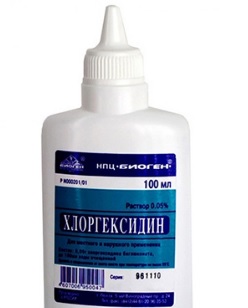
Pain in the postoperative period.
Painkillers. During the first two days, pain will be present for sure, because the operation was performed. You can stop the pain with the help of drugs Ibuprofen, Ketanov, Diclofenac, Nise, since they have an additional anti-inflammatory effect. Therefore, you should not endure, it is better to take a pill prescribed by a doctor, but you should not exceed the allowable dose.
Cold- for additional pain relief, you can apply cold to the cheek. For this, products that are in the freezer are not suitable. The maximum is a plastic container with ice cubes or water, wrapped in a towel, and even better in a cotton cloth soaked in water. A similar compress is applied for 15-20 minutes.
Duration of pain after removal. In the absence of complications, pain can be felt up to 7 days from the moment of tooth extraction. It becomes less intense every day and acquires a aching character, while it should not increase when eating. Depending on the complexity of the operation, the level of the patient's pain threshold and the experience of the doctor, the time of pain after extraction will also vary.
Swelling of the cheek.
Cheek always swells after tooth extraction. The reason for this is inflammation after injury. The swelling reaches its maximum volume by 2-3 days, while:
the skin of the cheek is neither hot nor red;
the pain does not increase;
no increase in body temperature is observed (the “behavior” of temperature is described below);
swelling does not extend to the neck, infraorbital region and chin.
What to do if the cheek is swollen after tooth extraction? If this condition is not accompanied by the symptoms listed above, then a cold compress can be applied to the cheek for 15-20 minutes, a similar procedure can be performed 3-4 times a day. If the increase in edema is accompanied by an increase in body temperature or a general deterioration in the condition, it is necessary to contact the dentist, because - this may be an allergic reaction to the drugs used during the operation, insufficient sanitation of the oral cavity and wounds after the operation, early warming up of the cheek in the postoperative period.
Temperature.
The temperature curve should behave like this:
after the operation (on the first day) it rises to a maximum of 38 0 C in the evening;
on the morning of the next day - not higher than 37.5 0 С;
on the second day in the evening - the norm.
Symptoms that differ from those described should be the reason for a visit to the doctor. It is forbidden to prescribe antibiotics on your own, only a specialist can do this.
Bad mouth opening.
The jaw after tooth extraction may not open well and hurt even normally. This happens when the dentist has to press on the tissues during the extraction of the tooth or the patient has to open his mouth wide to provide maximum access to the site of the operation (usually this happens when extracting a wisdom tooth), which results in swelling of the tissues. If such a condition is not a complication of the operation, then such a condition proceeds without an increase in swelling of the cheek, an increase in pain in the jaw, and an increase in temperature. On the contrary, the situation with excessive opening of the mouth passes by about 2-4 days.
Bleeding.
Bleeding can normally be observed during the day. If the patient is concerned about its intensity, then the following measures should be taken:
press a swab of sterile gauze or a ready-made hemostatic sponge to the wound for 20-30 minutes. After a while, you can repeat the manipulation;
you can take 2 tablets of Dicinone / Etamzilat. Tablets can be taken 3 times a day;
you can use a cold compress from a towel soaked in cold water. Apply a compress for 20 minutes to the cheek, after 3 hours you can repeat the manipulation.
If the discharge of ichor or bleeding continues for more than a day, it is imperative to visit the dentist. Most likely, such manifestations indicate the presence of an infectious complication.
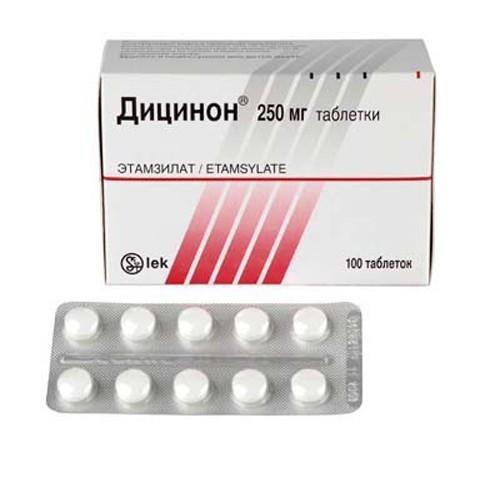
Hematoma on the skin of the cheek.
This phenomenon is not a complication in the postoperative period. Bruising most often occurs in the event of a traumatic tooth extraction, especially in people who suffer from arterial hypertension. Hematoma is the exit of blood from the vessels into the tissues, where post-traumatic edema used to be located.
Other questions.
Can health worsen after tooth extraction?? On the first day after surgery, stress can cause a lack of appetite, headache, and weakness. In the future, such manifestations disappear.
How long should it take after tooth extraction to return to the usual rhythm of life? Within a week, the pain disappears, swelling and bruising also disappear, the clot at the bottom of the hole begins to be tightened by epithelial tissue.
Complications
After tooth extraction, various complications can develop. The vast majority of them are infections that require the simultaneous prescription of antibiotics or, in extreme cases, surgical debridement of the focus of infection.
Dry hole.
This name has a condition in which, under the influence of vasoconstrictor drugs that are present in the composition of the anesthetic, or in case of non-compliance with medical recommendations after surgery (for example, active rinsing or eating solid food), a blood clot does not form in the well. Such a complication does not pose a threat to the life of the patient, but can cause the development of alveolitis - inflammation of the tooth socket, since the clot performs the function of protecting the gum tissue from infection and accelerates wound healing, respectively, when it is absent, then there is nothing to perform its function.
This condition is manifested by a long period of healing of the postoperative wound, the appearance of an unpleasant odor from the oral cavity, and the long-term preservation of the pain syndrome. The patient himself can, by looking in the mirror, determine that there is no clot in the hole, and the hole is not protected.
Having discovered such a condition, you should consult a doctor on the first day to correct the situation. Most likely, the dentist will perform a second, less painful intervention in the wound, which aims to form a new clot in the hole. If the presence of a dry socket was noticed later than the first day, then it is necessary to consult a doctor directly during the appointment or over the phone, he will explain what measures (in most cases these are dental gels and rinses) must be taken to prevent the development of alveolitis.
Alveolitis.
This name has a condition in which inflammation of the mucous membrane develops, which lines the recess in the jaw, where the tooth was located before the operation. This condition is dangerous because it can cause suppuration in the hole and the transition of infectious purulent inflammation to the soft tissues and bone tissue of the jaw. Alveolitis in most cases develops after the removal of molars, especially for the wisdom teeth located on the lower jaw, which are surrounded by a large amount of soft tissue.
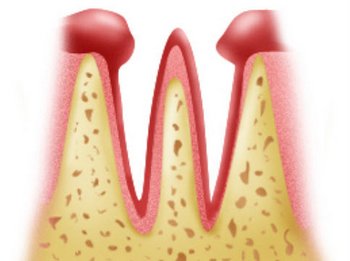
Causes of alveolitis:
decrease in general immunity;
extraction of a tooth, on the root of which a festering cyst was attached;
unsatisfactory processing of the tooth socket after its extraction;
violation of the integrity of the clot in the hole, most often, if desired, intensively rinse your mouth or clean the hole from food with toothpicks.
Symptoms of the development of alveolitis:
the pain that began to subside after the operation is growing again;
there is an unpleasant, putrid smell from the mouth;
pain radiates to both jaws, in some cases to the head area;
submandibular lymph nodes increase;
when pressing on the gum in the area of operation, pus or liquid begins to ooze from the hole;
after the removal of the tooth, the pan looks like this: the edges of the wound are reddish, the clot may have a black tint, the hole is covered with a dirty gray coating;
body temperature rises to 38 0 C and above with a feeling of ache, chills;
there is a headache, you want to sleep, the person gets tired quickly;
it hurts to touch the gums.
At home, you can help yourself:
rinse your mouth, but not intensively, often up to 20 times per knock, using antiseptic solutions for rinsing (for example, miramistin, chlorhexidine), salt solution;
do not remove the clot from the hole, even if there is an unpleasant odor coming from it;
you can drink non-steroidal anti-inflammatory drugs Ibuprofen, Nise, Diclofenac;
contact a dentist. Only he is able to cure alveolitis by performing wound curettage, inserting a tampon with an antiseptic into the wound and choosing the most appropriate antibiotic for the patient. It can be Colimycin, Neomycin, Lincomycin. Also, the doctor can refer the patient to physiotherapeutic procedures: treatment with a helium-neon laser, fluctuorization, microwave therapy, UVI.
Complications of alveolitis can be:
abscesses - accumulation of pus, limited by a capsule, in soft tissues;
osteomyelitis - inflammation of the bone tissue of the jaw;
phlegmon - the spread of a purulent process, which is not limited to the capsule and provokes the melting of healthy soft tissues of the jaw;
periostitis - inflammation of the periosteum of the jaw.
Osteomyelitis.
Purulent inflammation of the jaw bone, which is the most common complication of alveolitis. It can, in turn, be complicated by blood poisoning, so the treatment of this complication must be carried out in a hospital. Osteomyelitis is manifested by such symptoms:
loss of appetite;
increased fatigue;
the occurrence of a headache;
increased body temperature (above 38 degrees);
cheek swelling develops in the projection of the extracted tooth;
touching the jaw bone causes pain, while the further the process spreads, the larger areas of the jaw are affected;
develops severe pain in the jaw, which is growing.
Treatment of this complication is performed in the Department of Maxillofacial Surgery. The wound is drained, necrotic areas of the bone are removed, and antiseptic preparations are also injected into the wound. A course of systemic antibiotics is prescribed.
Nerve damage.
If the extracted tooth had a complex root system or it was located incorrectly, during the operation in such cases, the nerve that passes nearby may be damaged. This complication has the following symptoms:
the presence of "running" goosebumps;
the area of nerve damage becomes insensitive;
numbness in the cheeks, palate, tongue in the projection of tooth extraction.
Pathology is treated on an outpatient basis. Physiotherapy is used, a course of vitamin B and drugs that improve the conduction of impulses from nerve endings to the muscle are also prescribed.
Sharp edges of the alveoli.
After the extirpation of the tooth on the second day, when the edges of the gums begin to approach each other above the hole, pain occurs in this area. It is possible to distinguish such pain from alveolitis during the examination: pus does not separate from the hole, the edges of the gums are not red, the hole is still closed with a clot. The treatment of this complication is surgical - with the help of special tools, the sharp edges of the hole are excised, the wound is treated and a biomaterial is applied over it, which makes up for the lack of bone.
Exposure of the alveoli.
If the postoperative course passes within the normal range, however, during the use of warm food or mechanical irritation in the area of the hole, pain occurs, this may indicate that the area of \u200b\u200bthe bone is not covered with soft tissue.
This diagnosis can only be established by a dentist. Treatment of the pathology is surgical: the exposed area is removed, covering it from above with its own gum tissues, and stitches are applied.
postoperative cyst.
The development of a cyst after tooth extirpation is a rather rare complication of the operation. This is a kind of cavity near the root of the tooth, which is filled with fluid, so the body independently limits infected tissues from healthy ones. Such a cyst can grow in size and completely cover the tooth root, it can also spread to neighboring tissues, so this complication must be treated.
Such a cyst becomes noticeable after the development of periostitis, which is popularly called "flux". In such cases, a person turns to dentistry, where the disease is diagnosed and treated surgically, excising the pathological formation.
Perforation of the floor of the maxillary sinus.
This complication is the result of the manipulation itself, when in the process of tooth extraction a pathological connection is formed between the maxillary sinus and the oral cavity. Such a complication is possible with the removal of molars. You can diagnose the pathology using an x-ray, and the dentist can check for a message by asking the patient to exhale, then pinch his nose with his fingers and inhale. If there is a perforation, foamy (presence of air) blood will begin to appear from the hole.
Odontogenic phlegmon.
This name has a purulent fusion of soft tissues (spaces between the fascia, subcutaneous tissue, skin), which develops as a complication of osteomyelitis of the jaw.
The disease is manifested by painful and growing swelling of the cheek in the region of the lower or upper jaw. The skin over the edema is tense, very painful, it is rather difficult to open the mouth. In addition, there is a headache, malaise, body temperature rises. There is a decrease in appetite.
Treatment of this complication is carried out only surgically. Therapy consists in opening the infiltrate and washing the damaged areas with antibiotics, and systemic antibiotics are also prescribed.
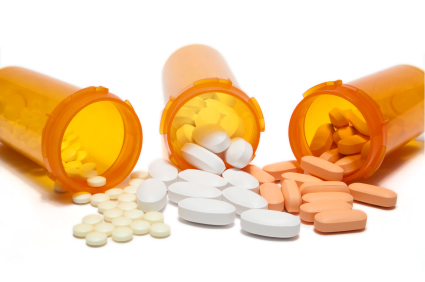
Odontogenic periostitis.
This complication is a complication of osteomyelitis or alveolitis and is manifested by the spread of inflammation to the periosteum. In the people, such a pathology should be called "flux". There is a complication:
an increase in body temperature;
persistent toothache;
swelling of the cheeks on one side.
Abscesses of the soft tissues of the jaw.
This disease in its early stages is not particularly different from phlegmon. However, here, the tissues melted by pus are limited from healthy capsules, while with phlegmon, inflammation continues to advance and affect more and more new tissue areas.
A manifestation of odontogenic abscesses is pain in the entire jaw, weakness, an increase in body temperature to high numbers, difficulty in opening the mouth, an increase in local temperature in the area of skin edema, and the development of significant cheek edema.
Treatment of complications is carried out in a hospital and is surgical - they open and drain the formed abscess, wash it with antiseptic solutions. In addition, systemic antibiotics are injected into a vein or muscle.
Antibiotics for tooth extraction
appointment cases.
When removing teeth, antibiotics are not always prescribed, it all depends on each specific case. If, after the extirpation of the tooth during the control visit, the doctor finds signs of inflammation, then in most cases antibiotics are prescribed. There are also a number of factors that imply the appointment of antibiotics in case of complication of tooth extraction:
- if during the extraction of the tooth its hole was damaged, which as a result led to the penetration of the infection further into the tissues;
- if, after tooth extraction, the wound does not heal for a long time, due to weakening of local immunity;
- if a thrombus does not form in the well or it is insolvent. In such cases, antibiotics are prescribed to protect the well from infection.
drug requirements
After tooth extraction, it is necessary to prescribe those antibiotics that meet a number of requirements:
low level of toxicity;
the minimum number of side effects;
the drug must have the ability to quickly penetrate into soft and bone tissues;
the drug must have the ability to accumulate in the blood in certain quantities and maintain a local effect for 8 hours.
What drugs should be prescribed.
In the question of which antibiotics should be prescribed for admission after tooth extraction, it is quite difficult to give an unambiguous answer, because each patient's body can react differently to them, so the doctor decides this question directly at the time of admission. The only thing that can be done regarding the determination of antibiotics for tooth extraction is to indicate which of them are used most often. Modern dentistry most often uses Metronidazole and Lincomycetin. These drugs are often even prescribed in combination, to ensure the best effect. Thus, Lincomycin take two capsules with an interval of 6-7 hours, the course of therapy is up to 5 days. At the same time, Metronidazole acts as a maintenance drug and is taken one tablet three times a day, the course is 5 days.
Contraindications.
When prescribing antibiotics after tooth extraction, the doctor must be warned about the presence of body features. So, the dentist should be informed about the pathologies of the gastrointestinal tract, liver, heart. It is also worth providing all the information regarding the use of other medicines.
If the patient has a pathology of the gastrointestinal tract, then the doctor should prescribe antibiotics in an effervescent form. Such funds dissolve much faster and do not irritate the stomach and intestines. The main thing that needs to be understood once and for all is that only a doctor can prescribe any drugs, and then only after a thorough examination.





